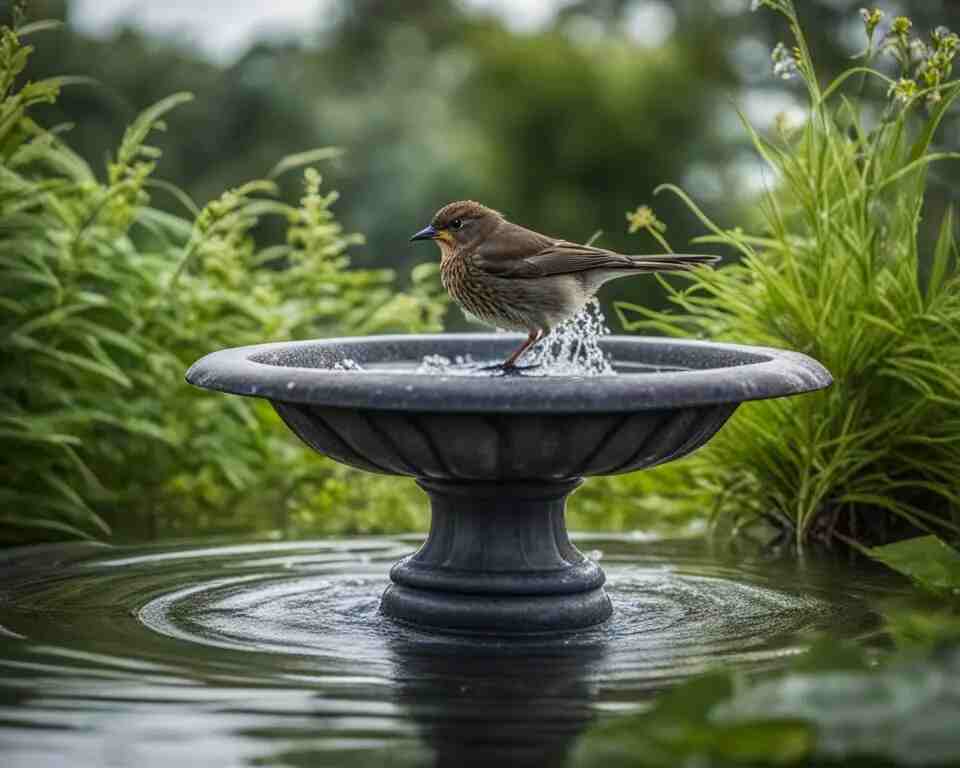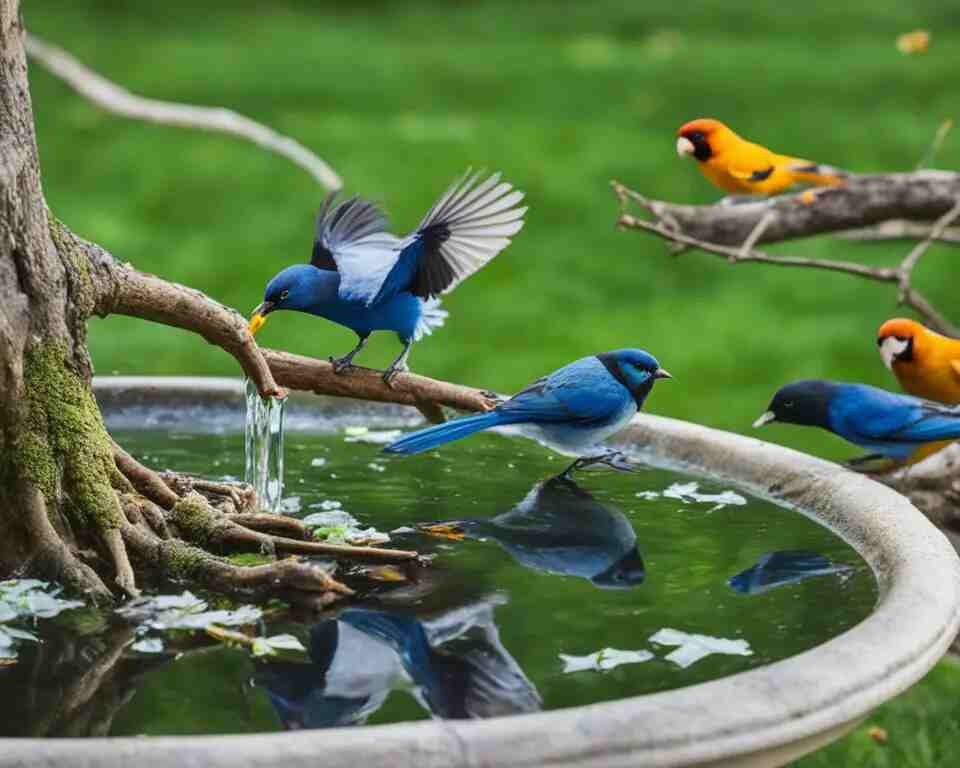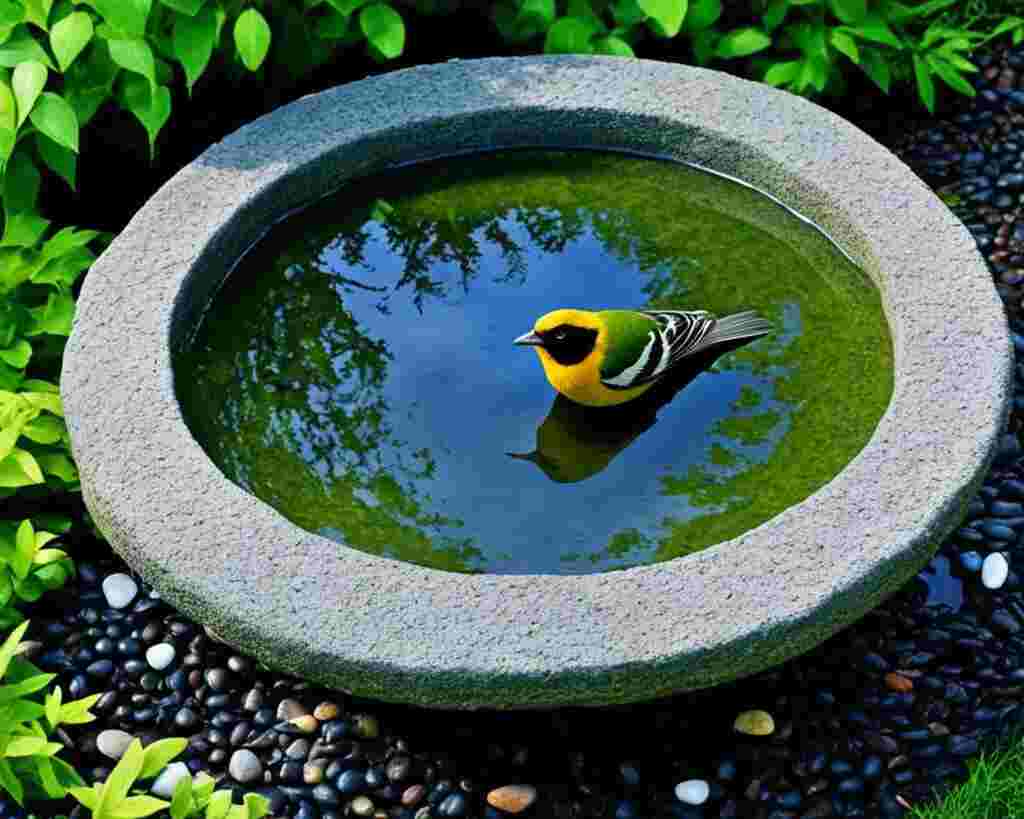Bird baths can be a lovely addition to any garden, providing birds with a water source for drinking and bathing. However, it’s important to be aware of the potential risks and take precautions to prevent accidents.
In this article, I will explore the question of whether birds can drown in a bird bath and provide safety tips to keep our feathered friends protected.
Table of Contents
- 1 Key Takeaways:
- 2 Understanding the Risks: Can Birds Drown in a Bird Bath?
- 3 Essential Bird Bath Maintenance for Avian Safety
- 4 Safe Bird Bath Placement to Protect from Predators
- 5 Optimizing Water Depth and Adding Safeguards
- 6 Alternative Bird Bathing Options to Maximize Safety
- 7 Conclusion
- 8 Source Links
- 9 Author
Key Takeaways:
- Birds can drown in a bird bath under certain circumstances, especially small or weak swimmers.
- Factors like bird bath depth, design, water quality, and the presence of predators can contribute to drowning risks.
- To prevent accidents, regularly clean and disinfect the bird bath, monitor water quality, and choose non-toxic materials.
- Place the bird bath high up and near trees or bushes for protection from predators.
- Optimize water depth, provide perches, and maintain fresh water to maximize safety.

Understanding the Risks: Can Birds Drown in a Bird Bath?
While birds are naturally skilled at swimming and navigating bodies of water, they can indeed drown in a bird bath under certain circumstances. This is especially true for small birds or birds that are not strong swimmers.
Factors such as the depth and design of the bird bath, the presence of predators, and water quality can all contribute to the risk of bird bath drowning. Bird baths that are too deep or have smooth, slippery surfaces can make it difficult for birds to escape if they accidentally fall in. Additionally, the presence of predators, such as cats or raccoons, near the bird bath can pose a threat to birds while they are vulnerable in the water.
Water quality is another important factor to consider when it comes to bird bath safety. Dirty or contaminated water can harbor bacteria and parasites that can harm birds. Chemicals such as chlorine or pesticides can also be toxic to birds, even in small concentrations.
To prevent bird bath drownings and ensure avian safety, it is crucial to take appropriate measures. Maintaining a shallow water level in the bird bath, providing escape routes such as rocks or perches, and regularly cleaning and replenishing the water can all help reduce the risk of drowning. Additionally, positioning the bird bath in a safe location away from potential predators is essential.
By understanding the risks involved and implementing necessary safety measures, we can create a bird bath environment that is both inviting and safe for our feathered friends.
Essential Bird Bath Maintenance for Avian Safety
To maintain a safe and healthy environment for birds, proper maintenance of the bird bath is crucial. By following these essential maintenance practices, you can ensure the safety and well-being of your feathered visitors.
Cleaning and Disinfecting Your Bird Bath
Regular cleaning and disinfecting of the bird bath are necessary to prevent the buildup of bacteria and the spread of diseases. Stagnant water can become a breeding ground for harmful microorganisms, posing a risk to the health of birds.
To clean your bird bath:
- Empty the existing water from the bird bath.
- Scrub the surface of the bird bath with a brush and mild bleach solution.
- Rinse the bird bath thoroughly with clean water to remove any residue.
- Refill the bird bath with fresh, clean water.

Regular cleaning and disinfecting will help maintain a hygienic environment for the birds and prevent the spread of diseases.
Monitoring Water Quality to Prevent Disease
Regularly monitoring the water quality in your bird bath is crucial for the health and safety of birds. Contaminated water can be toxic and harmful to the avian visitors. To ensure water quality:
- Check the water for any signs of contamination or discoloration.
- Replace the water with fresh, clean water on a regular basis.
- Avoid using water that may contain pesticides or chemicals.
By maintaining clean and fresh water in the bird bath, you can help prevent the spread of diseases among the avian visitors.
Choosing Non-toxic Materials for Bird Baths
When selecting a bird bath, it’s essential to choose materials that are non-toxic and safe for birds. Avoid using chemicals or toxic substances to clean or treat the bird bath, as these can be harmful to the avian visitors.
Opt for bird baths made from non-porous materials, such as ceramic or glass, that can be easily cleaned and disinfected. Ensure that any paints or sealants used on the bird bath are non-toxic and do not pose a risk to avian health.
By choosing non-toxic materials, you can create a safe and healthy environment for birds to drink and bathe in.
Safe Bird Bath Placement to Protect from Predators
When it comes to bird bath safety, the placement of the bird bath plays a critical role in protecting birds from potential predators. By positioning the bird bath in a safe and strategic location, we can ensure that our feathered friends can enjoy their baths without fear or danger.
To protect birds, it is essential to position the bird bath high up in the air. Placing it on a pedestal or mounting it on a post will make it harder for predators to reach. This elevated positioning will create a safer environment for the birds to drink and bathe.
In addition to the height, it’s important to consider the surroundings of the bird bath. Ideally, place the bird bath near trees or bushes that birds can use as cover. These natural elements will provide birds with a sense of security, allowing them to quickly seek shelter if they feel threatened.
On the other hand, avoid placing the bird bath in open and exposed areas where it is vulnerable to ambushes. Placing it near dense shrubs or foliage can create visual barriers for predators, making it harder for them to approach the bird bath undetected.
By implementing these safe bird bath placement guidelines, we can create a secure and protected environment for birds to enjoy their baths. So let’s carefully consider the placement of our bird baths to ensure the safety and well-being of our avian visitors.
Optimizing Water Depth and Adding Safeguards
To prevent drowning accidents in bird baths, it’s crucial to optimize the water depth and implement additional safeguards. By considering the water level and providing alternative perching options, we can enhance avian safety and enjoyment.
Implementing a Shallow Water Design for Your Bird Bath
Choosing a shallow bird bath is an effective way to minimize the risk of drowning. Opt for a bird bath with a water depth of less than 5 cm. Alternatively, you can add rocks or gravel at the bottom of the bird bath to create multiple platforms for birds to perch on while they drink or bathe. This allows them to access the water in a safe and stable manner, reducing the chances of submersion.
Using Rocks and Sticks as Natural Perches
Incorporating rocks or sticks as natural perches provides an additional layer of safety for birds using the bird bath. By placing these objects across the top of the bird bath, we create perching options for birds to comfortably drink without entering the deeper parts of the water.
Not only does this help prevent drowning accidents, but it also discourages birds from venturing into the areas where they may be at risk. By offering these alternative perching options, we can ensure avian safety while they enjoy the benefits of the bird bath.

| Sunlight Exposure | Effect on Birds |
|---|---|
| Full Sunlight | Water may heat up quickly, making it uncomfortable for birds. |
| Partial Shade | Ideal conditions for birds, providing protection from direct sunlight while still allowing them to enjoy the bird bath. |
| Dappled Sunlight | Similar to partial shade, dappled sunlight creates a soothing and comfortable bathing environment for birds. |
By considering both the proximity to feeders and water sources and the balance of sunlight and shading, you can optimize the positioning of your bird bath to attract a wide variety of bird species and create a safe and inviting space for them to drink and bathe.
Alternative Bird Bathing Options to Maximize Safety
Hummingbirds and smaller bird species have unique bathing needs. To ensure their safety and enjoyment, it’s important to adapt bird bath designs specifically for them. Consider incorporating shallow pools or misters to mimic their natural bathing habits. Providing perches and smaller drinking areas will contribute to a safer environment for these delicate birds.
Adding movement to the bird bath can maximize safety and attract a wider variety of birds. Fountains and drippers provide a continuous flow of fresh water, preventing stagnation and creating an inviting environment for birds. The sound and sight of flowing water will also act as a natural deterrent for potential predators. By incorporating these features, birds will be drawn to the bird bath while feeling secure and protected.
By adapting bird bath designs to meet the specific needs of hummingbirds and smaller species, we can create a safe and appealing bathing environment for these unique birds. Adding movement through fountains and drippers not only maximizes safety but also enhances the overall attractiveness of the bird bath. Let’s create a bird-friendly oasis that will delight both the feathered visitors and ourselves.
Conclusion
Creating a safe and inviting environment for birds in your bird bath is crucial to their well-being. By implementing the bird bath safety tips discussed in this article, you can ensure that your feathered friends have a secure space to drink and bathe.
Regular cleaning and disinfecting of the bird bath, along with monitoring the water quality, will help prevent the spread of diseases and contaminants. Maintaining an optimal water depth and incorporating safeguards such as shallow designs and perches will minimize the risk of drowning and provide birds with safe access to water.
Strategic bird bath placement near cover and away from predators, as well as thoughtful consideration of sunlight and shading, will contribute to a more comfortable and secure bathing experience for birds. Finally, exploring alternative bird bath options like adaptations for smaller species and incorporating movement can attract a diverse array of birds while enhancing their overall safety and enjoyment.
In conclusion, by following these bird bath safety tips, you can create a haven for birds that not only meets their needs but also contributes to their health and happiness. So go ahead and implement these measures, and watch as your bird bath becomes a popular destination for our feathered friends!


